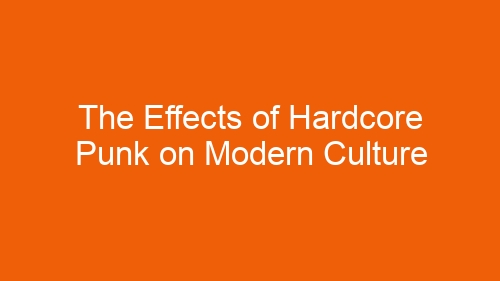-
Table of Contents
Influence of Hardcore Punk Fashion on Streetwear Trends
Hardcore punk, a subgenre of punk rock that emerged in the late 1970s, has had a significant impact on modern culture in various ways. One of the most notable influences of hardcore punk can be seen in the realm of fashion, particularly in streetwear trends. The DIY ethos and rebellious spirit of hardcore punk have inspired a distinct style that continues to resonate with fashion enthusiasts and subcultures around the world.
The influence of hardcore punk fashion on streetwear trends can be traced back to the early days of the genre. Hardcore punk bands and fans rejected mainstream fashion norms and instead embraced a more rugged and utilitarian aesthetic. This rejection of conformity and emphasis on individuality laid the foundation for the DIY approach that would come to define hardcore punk fashion.
One of the key elements of hardcore punk fashion is its emphasis on functionality and durability. Clothing items such as combat boots, leather jackets, and ripped jeans became staples of the hardcore punk wardrobe, reflecting the genre’s raw and aggressive sound. These items were often customized and personalized by fans, further emphasizing the DIY ethos of hardcore punk.
As hardcore punk gained popularity in the 1980s and 1990s, its influence on streetwear trends became more pronounced. Brands such as Vans, Converse, and Dr. Martens, which were favored by hardcore punk fans, began to gain mainstream appeal and became synonymous with the genre’s aesthetic. The iconic checkerboard pattern of Vans sneakers, for example, became a symbol of rebellion and nonconformity, reflecting the ethos of hardcore punk.
In addition to footwear, hardcore punk fashion also influenced the design of graphic t-shirts and hoodies. Band logos, political slogans, and provocative imagery were commonly featured on these garments, serving as a form of self-expression and a means of conveying a message. This DIY approach to graphic design has since become a hallmark of streetwear brands, many of which draw inspiration from the punk subculture.
The influence of hardcore punk fashion on streetwear trends can still be seen today. Brands such as Supreme, Stussy, and Off-White continue to draw inspiration from the DIY ethos of hardcore punk, incorporating elements such as distressed denim, bold graphics, and utilitarian details into their collections. These brands have helped to popularize the hardcore punk aesthetic and bring it to a wider audience, further cementing its place in modern fashion.
In conclusion, the influence of hardcore punk fashion on streetwear trends is undeniable. The DIY ethos, rebellious spirit, and emphasis on individuality that define hardcore punk have inspired a distinct style that continues to resonate with fashion enthusiasts and subcultures around the world. From combat boots to graphic t-shirts, the legacy of hardcore punk can be seen in the design of clothing items that have become synonymous with streetwear culture. As fashion continues to evolve, the influence of hardcore punk on modern culture is likely to endure, shaping the trends and styles of future generations.
Impact of Hardcore Punk Music on Contemporary Music Genres
Hardcore punk music emerged in the late 1970s as a raw and aggressive form of punk rock. Known for its fast tempo, short songs, and intense lyrics, hardcore punk quickly gained a dedicated following among disaffected youth looking for an outlet for their anger and frustration. While hardcore punk may have started as a niche subgenre, its influence on modern music cannot be overstated.
One of the most significant impacts of hardcore punk on contemporary music genres is its DIY ethos. Hardcore punk bands often eschewed traditional record labels and instead released their music independently. This DIY approach to music production and distribution has since been adopted by artists across a wide range of genres, from indie rock to hip-hop. The rise of streaming platforms and social media has made it easier than ever for artists to connect directly with their fans, bypassing the traditional gatekeepers of the music industry.
In addition to its DIY ethos, hardcore punk also had a profound impact on the sound of contemporary music. The fast, aggressive guitar riffs and pounding drums of hardcore punk can be heard in everything from metalcore to post-hardcore. Bands like Black Flag and Minor Threat paved the way for a new wave of aggressive, politically charged music that continues to resonate with audiences today.
Furthermore, the lyrical content of hardcore punk has had a lasting impact on modern music. Hardcore punk bands often tackled social and political issues head-on, addressing topics like racism, sexism, and police brutality. This willingness to confront difficult subjects has inspired a new generation of artists to use their platform to speak out against injustice and advocate for change.
The influence of hardcore punk can also be seen in the fashion and aesthetic of contemporary music. The DIY ethos of hardcore punk extended beyond music to include fashion, with bands and fans alike embracing a DIY approach to clothing and style. The iconic black leather jackets, ripped jeans, and combat boots of hardcore punk have since become staples of alternative fashion, influencing everything from streetwear to high fashion.
In conclusion, the impact of hardcore punk on modern culture cannot be overstated. From its DIY ethos to its aggressive sound and politically charged lyrics, hardcore punk has left an indelible mark on contemporary music genres. The influence of hardcore punk can be seen in everything from the way music is produced and distributed to the way artists engage with social and political issues. As we look to the future of music, it is clear that the legacy of hardcore punk will continue to shape and inspire artists for years to come.
Evolution of Hardcore Punk Ideologies in Social and Political Movements
Hardcore punk music has long been associated with rebellion, anti-establishment sentiments, and a DIY ethos. Originating in the late 1970s as a more aggressive and raw form of punk rock, hardcore punk quickly gained a following among disaffected youth who were looking for a way to express their frustrations with society. Over the years, hardcore punk has evolved and diversified, influencing not only the music scene but also social and political movements around the world.
One of the key characteristics of hardcore punk is its emphasis on authenticity and sincerity. Unlike mainstream music genres that often prioritize commercial success and image over substance, hardcore punk bands are known for their raw and unpolished sound, as well as their uncompromising lyrics that tackle issues such as social injustice, political corruption, and personal struggles. This commitment to speaking truth to power has made hardcore punk a powerful tool for social and political activism.
In the 1980s, hardcore punk became closely associated with the straight edge movement, which promoted a drug-free and abstinent lifestyle. Straight edge bands like Minor Threat and Youth of Today used their music to advocate for sobriety and self-discipline, inspiring a generation of young people to reject the excesses of mainstream culture and embrace a more mindful way of living. This ethos of self-restraint and personal responsibility continues to resonate with many hardcore punk fans today, who see it as a way to resist the temptations of consumerism and conformity.
As hardcore punk spread beyond its origins in the United States and the United Kingdom, it began to influence social and political movements in other parts of the world. In countries like Brazil, Japan, and Indonesia, hardcore punk scenes emerged as a form of resistance against authoritarian regimes, economic inequality, and cultural imperialism. Bands like Ratos de Porão, Gauze, and Marjinal used their music to challenge the status quo and give voice to marginalized communities, inspiring a new wave of activists and organizers to fight for social change.
In recent years, hardcore punk has continued to evolve and adapt to the changing cultural landscape. With the rise of social media and digital technology, bands and fans are able to connect and collaborate in ways that were previously impossible, allowing for greater diversity and inclusivity within the scene. This has led to the emergence of new subgenres and styles of hardcore punk, as well as a renewed focus on issues such as mental health, gender equality, and environmental sustainability.
Despite its underground status, hardcore punk has had a lasting impact on modern culture, influencing not only music but also fashion, art, and activism. Its DIY ethos and anti-authoritarian spirit have inspired countless individuals to question the status quo and strive for a more just and equitable society. As we look to the future, it is clear that hardcore punk will continue to be a powerful force for social change and cultural transformation, challenging us to think critically and act boldly in the face of injustice.




















